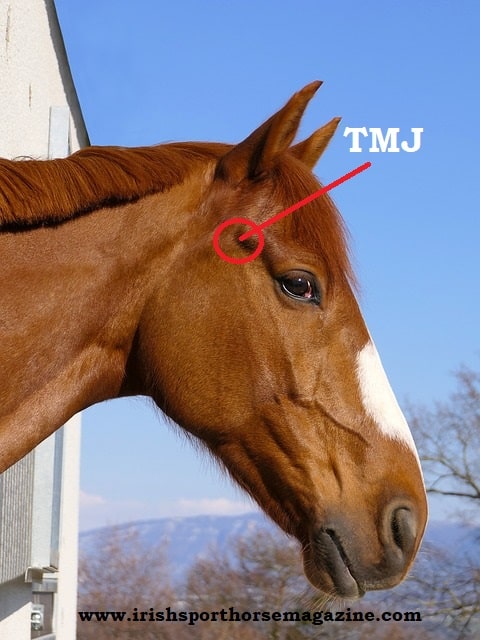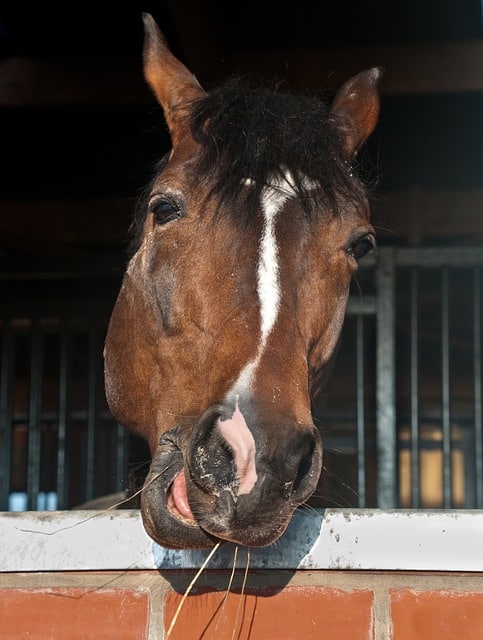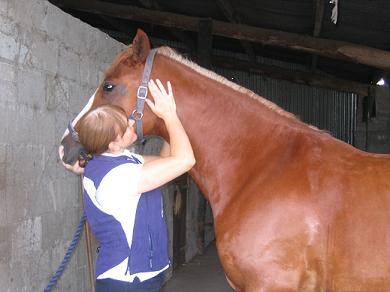Throughout history the Horse has had to deal with a lot when it comes to humans. Not only did we domesticate the horse, but we then jumped on its back, put a bit in its mouth and boldly rode it into battle, amongst other equally heavy duty workloads, such as pulling carts etc. The horse has been our mode of transport and our partner in many of our industrial endeavours, however in recent times the horse has become more of a recreational animal, being used for both Sport and Pleasure riding.
Perhaps it is this change in the use of the horse and the increase in the sporting demands placed up on it that has lead to the rise in issues such as Temporomandibular Joint Pain (TMJ Pain). The TMJ is the jaw joint of the horse, and as the horse eats vegetation, and is a plains grazer, the TMJ it is subject to quite a bit of movement to allow for the opposition of the molars to break down the food that the horse eats. In this article we will outline the anatomy of the TMJ, along with the symptoms of pain or dysfunction in the joint; some common causes of issues within the joint; diagnosis and treatment options.

Temporomandibular Joint – TMJ.
The Temporomandibular Joint or TMJ is formed between the Temporal Bone of the Maxilla or upper jaw bone and the Mandible or Lower Jaw bone. You can locate it by running a straight line back from the corner of the horse’s eye and running a straight line from the base of the horse’s ear, where the two meet is the joint(see diagram). There are two TM joints, one on each side of the horse’s head. Each joint is cushioned by a disc of Fibrocartilage the sits between the articular surface of both bones. Unlike other joints in the horse’s body which are covered with Hyaline Cartilage, the joint surfaces of the TMJ are covered with Fibrocartilage. The intra articular disc separates the TMJ in the horse into two compartments, the dorsal compartment which is nearer to the top of the horses head and ventral compartment which is below it. When the joint is functioning correctly there is no communication between the compartments. As previously mentioned the joint is designed to allow quite a bit of movement particularly side to side as the horse being a herbivore needs to grind the vegetation it eats with its molars.
Check Out Our Video Discussing TMJ Pain in Horses.
Symptoms of a Problem with the TMJ.
Problems with the TMJ in humans have been well documented and this joint can cause a variety of problems from pain and discomfort within the joint itself, while also causing a wide variety of symptoms such as headache, neck ache, dizziness, earache and visual problems to name a few. With the horse however, the symptoms can be similar to other conditions so it can be difficult initially to pinpoint the cause. Some common Symptoms in horses are;
- Quidding
- Difficultly chewing food.
- Loss of Mobility of the Mandible
- Pain at the site of the Joint itself
- Inflammation in the Joint
- Behavioural Problems such as being difficult to Bridle, Head Shaking, inability to take up a contact through the reins when being ridden; not wanting to go forward, and if problem goes undetected, this could lead to more potentially dangerous behavioural issues such as rearing.
Causes of TMJ Problem in Horses.
The primary cause of a TMJ problem in horses would most likely be trauma, such as a kick from another horse, being cast in a stable, or a fall cross country; any such traumatic event could cause, subluxation (partial dislocation) of the jaw and or fracture. Soft Tissue problems following trauma can lead to the condition becoming more chronic leading to the horse developing a secondary arthritic condition within the joint following the accident; TMJ pain can be the result of an infection within the joint; or perhaps poor conformation of the Jaw.
Also, because of the way horses use their jaw to eat their food, this causes the teeth to wear unevenly, therefore, regular visits from the equine dentist is important for a healthy TMJ in the horse. Although, with age there can be some arthritis within the joint particularly if the horse has had a very active sporting life.
As Equestrians I believe that it is important for us when working with horses that we do everything as correctly as possible. Therefore, lunging a horse directly off the bit is not a good idea, and if this has to be done then it should be done correctly by passing the lunge line through the bit and over the horses head and then clipping to the bit on the far side.

NB** Lunging off the bit by running the lunge line through the bit around the back of the horses chin and clipping the lunge rope to the bit the far side, is potentially very bad for your horse’s jaw should they spook or pull with any force, this would put unnecessary strain on the TMJ, perhaps predisposing it to injury. Therefore to protect the horse, lunge off a cavesson or headcollar. If you have a particularly strong horse use the lunge line over the horses head as described above.
A correctly fitting bit and bridle is also very important to the integrity of the TMJ, so if you are having problems, perhaps get your coach or a bitting expert to help you out.
Diagnosis TMJ Problems in Horses.
If you suspect that your horse has TMJ problems, then contact your vet and get them to make a full examination. This will usually start with palpation of the joint itself, testing for swelling, pain and any restrictions in movement. Based on your description of your horses symptoms coupled with their findings on examination of the joint itself, the vet may recommend an injection of anesthesia into the joint; If the animal’s symptoms improve or disappear, this a positive result for TMJ involvement.
X-Rays of the TMJ in horses, can be difficult to read and do not always yield a definitive result, because of position of the joint in relation to the equine skull. Computed Tomography can yield better images of the Joint, while MRI is beneficial in determining the soft tissue damage involved. However both these methods require the animal to undergo a general anaesthetic and therefore are costly and not often used; injection of anaesthetic into the joint is the most commonly used diagnostic procedure to determine if there is a problem with the joint. If infection is suspected, then fluid from the joint is extracted and tested to determine the type of infection.
Treatment of a TMJ Problem in Horses.

The Treatment of a TMJ problem in the horse will be determined by the cause. If the horse has had a trauma such as a kick, there will be a period of rest, followed by anti-inflammatory injections and or medication, that will take care of any bruising or inflammation within the joint. If it is felt that the issue is related to the teeth, this will be addressed and medication or injections prescribed as necessary. If infection is the root cause, then antibiotics will be administered, and occasionally the joint will need to be flushed.
If misalignment of the jaw is the problem Chiropractic Treatment can prove beneficial in restoring the correct alignment and flexibility. Along with Chiropractic, both Massage and Acu Puncture can help animals with more chronic problems, relieving symptoms and keeping the animal flexible and happy.
Conclusion.
TMJ problems in horses have not been well researched to date; this is likely due the position of the joint and the difficulty in getting clear diagnostic imaging. The simplest diagnostic tool for pain within the joint remains injection of the joint with anaesthetic to see if symptoms improve, this coupled with the physical examination of the area appears to be main method for veterinary diagnosis in many cases.
Therefore as Equestrians we must do everything we can to ensure that our horse has a minimal risk to injury of the area. This can accomplished by ensuring that any equipment is correctly fitted for the horse, while also making sure all lunging is performed in the correct way; this coupled with having the Horse’s teeth regularly checked i.e. twice yearly will reduce any risk of injury to the area in many cases. Also for the rider it is important to have regular Chiropractic or Physiotherapy to keep their musculoskeletal system, balanced and flexible and to remove any restrictions that may have a negative impact on the horse.
Above all listen to the horse, recognise what is normal for your own horse and if there is any change in their behaviour you will recognise the symptoms at the earliest onset and get the appropriate veterinary attention required.
References; H.D. Moll DVM MS, Diplomate ACVS & K.A. May DVM, MS, Diplomate ACVS – A Review of Conditions of the Equine Temporomandibular Joint – 2002 – Smyth & Goody – Horse Structure & Movement – Dr Marcos Wurschmidt PHD – Temporomandibular Joint Disease – www.sporthorses.vet – Dr L. Gray – Temporomandibular Joint Conditions in Horses – www.smartpakequine.com
This Article was originally published in the March 2020 Issue of Irish Sport Horse Magazine.
